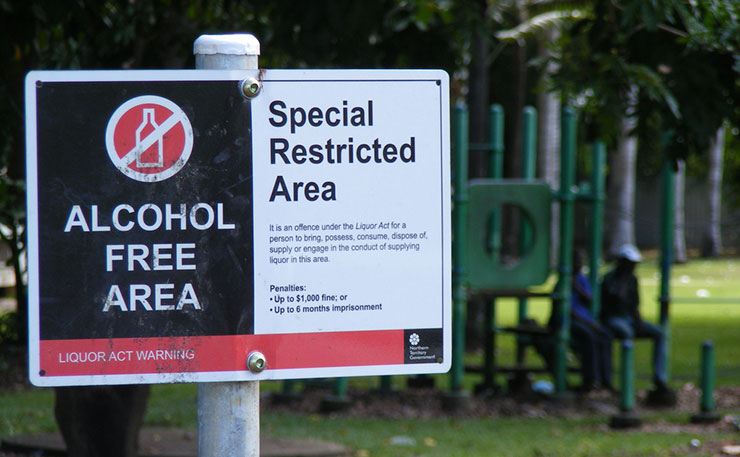In the second in a two part series, Michael Brull analyses the laws that led to another Aboriginal death in custody in Darwin.
The implicit message from the Government and senior police command was that Aboriginal people drinking in designated public places could and should be taken off the streets and detained…
Coroner Cavanagh writes that there was no need for Kumanjayi to be arrested. The maximum penalty for the offence he was suspected of committing was a $74 fine (with a victim’s levy of $40).
The police wrote out the infringement notice before Kumanjayi had even arrived at the Watch House.
“Yet although the offence carried no term of imprisonment,” Cavanagh wrote, “Kumanjayi was handcuffed in public, placed in an iron cage in the back of a police van, transported away from his family and friends, presented at the watch house counter with his arms still handcuffed behind his back, searched, deprived of his property, sat down and made to take his shoes and socks off and detained for some hours in a cell built to house criminals.”
Why?
Part of the story is the new paperless arrest scheme in the NT. Part of it was a police special operation called Operation Ascari II, whose stated purpose was to “reduce the number of alcohol related and anti-social behaviour incidents throughout the Darwin and Casuarina regions.”
What was the combined effect of these two regimes? Cavanagh writes it over and over.
It “encourages the arrest of public drinkers, almost all of whom are indigenous” (sic – Cavanagh uses lower case “Indigenous” throughout the Inquest. Ed’s Note: although Cavanagh assigns ‘Police’ a capital p on multiple occasions).
The “implicit message from the Government and senior police command was that Aboriginal people drinking in designated public places could and should be taken off the streets and detained for up to four hours, or longer if they needed more time to sober up.”
And: “… in operation, the combination of the paperless arrest scheme and Operation Ascari II resulted in Police picking up people drinking in public parks, almost all of whom are indigenous” (sic).
Cavanagh writes of the evidence given by police “on the street” dealing with the paperless arrest scheme and Operation Ascari II. They gave evidence that “the majority of those picked up for drinking in a public place are indigenous (sic) and Sergeant Paul Jones agreed with Counsel Assisting when it was put to him that 95 per cent of those detained in police cells for liquor offense are indigenous (sic).”
The police were unable to give detailed statistics on people detained under the paperless arrest scheme, although extrapolating from what was provided, Cavanagh estimated that “upwards of 80 per cent” of those released with infringement notices are Aboriginal.
This option was exercised 1,807 times in the NT from December 2014 to July 2015. However, the fact that there are no reliable statistics on the detainees and their impact on Aboriginal people was also slammed by Cavanagh as unacceptable, as inconsistent with the recommendations of the Royal Commission into Aboriginal Deaths in Custody, and denying a tool to evaluate the “effectiveness” or “adverse impact” of the scheme.
Nevertheless, Cavanagh observed that it is “glaringly apparent that the paperless arrest scheme disproportionately impacts on Aboriginal Territorians”, who make up the “vast majority” of those detained under the new laws, though they are only about 29 per cent of the general population.
He observes that it is “no coincidence” that an Aboriginal man was the first person to die in custody since the paperless arrest laws began. These laws are “manifestly unfair”, and “irreconcilable with the recommendations of the Royal Commission” into Aboriginal Deaths in Custody.
These laws have exacerbated an already severe racial disparity in the NT, whereby Aboriginal and Torres Strait Islanders comprise 86 per cent of adult prisoners in the NT (remember, they are only 29 per cent of the population). The NT has the highest imprisonment rate across all states and territories in Australia, and the highest proportion of Aboriginal and Torres Strait Islander prisoners.
Cavanagh also comments on the racially discriminatory nature of the policing of drinking offences in the NT.
Located just one street away from Spillet Park, where Kumanjayi was enjoying a quiet drink with friends, are a host of pubs and bars… Those establishments… have al fresco drinking areas that are popular with the non-indigenous locals and tourists, many of whom imbibe large amounts of alcohol… Senior Constable Deutrom… confirmed that they have dress Codes that would have precluded Kumanjayi Langdon and other Aboriginal drinkers he had been arresting from entering.
The new laws create a system where a large proportion of the population drinks freely in pubs and taverns using sections of the public footpath that have been fenced off for outdoor drinking. Just one street away, Aboriginal people (some of whom have come in from communities that are under federal fiat banning alcohol…) are being detained for drinking in a designated public place, even if they are enjoying peaceful, quiet time with family and friends.
That deprivation of liberty and the differential treatment it results in is unacceptable.
It is not just the racist application of the law which offended Cavanagh. He quoted former High Court Justice Deane, who observed that “The customary companions of arrest are ignominy and fear. A police power of arbitrary arrest is a negation of any true right to personal liberty. A police practice of arbitrary arrest is a hallmark of tyranny.”
It is hard to find any other way to describe a law that gives police the power to arrest people – primarily Aboriginal people – because they might commit a trivial offence.
Cavanagh wrote that “His Honour’s words are an important reminder of the indignity and shame that can be felt by being arrested… a civilised society does not subject its citizens to that mortification unless there are no other reasonable options open.”
Yet as noted, it was “Government and senior police command” policy to lock up Aboriginal people drinking in public. Why? Counsel for the NT Police and Department of Health “conceded that the system of arrest for infringement notices relating to public drinking was being used, in effect, for the purpose of preventative detention.”
He submitted that this was “likely to reduce further, more serious offending”. Cavanagh writes that this matter reveals that “some Aboriginal prisoners are being held for reasons of preventative detention; in the case of Kumanjayi Langdon that he might drink again in public.
This sick, middle-aged Aboriginal man was treated like a criminal, incarcerated like a criminal, and died in a police cell built for criminals.”
At this point we should pause. The High Court explicitly upheld these laws, on the basis that they were supposed to exclude this kind of detention. Though the Attorney-General said they were intended to ensure that they “will no longer become arrest averse”, and if “clowns are playing up, arrest them, take them into custody”, Justices Nettle and Gordon rejected concerns that the law would be used in this way as “unwarranted”.
Chief Justice French, and Justices Bell and Kiefel held that detention under the new laws were not “for a punitive or penal purpose”. The facts as to what the Attorney-General said, what the police admitted they were using the laws for, and what Counsel for the NT Police conceded in this matter apparently was of little effect.
Returning to the Inquest, Cavanagh said that whilst it would ordinarily not be appropriate for him to criticise democratically passed laws, he was “compelled to do so” under his powers. There is “so clear a link between the introduction” of the paperless arrests “and an increase in the incarceration of Aboriginal people”. He recommended that the paperless arrest laws that came into operation on December 2014 be repealed, so as to prevent the risk of an increase in the numbers of deaths in circumstances similar to Kumanjayi Langdon.
Cavanagh observed that
The grief and sadness that a family feels at the death of their loved one is compounded where that death occurs in custody, away from family and friends. Kumanjayi had the right to die as a free man and in the circumstances, he should have done. In my view, unless the paperless arrest laws are struck from the Statute books, more and more disadvantaged Aboriginal people are at risk of dying in custody, and unnecessarily so.
Kumanjayi may not have died in the shocking circumstances of Kwementyaye Briscoe, or Ms Dhu. But he still died after a nurse ignored his repeated requests for a doctor, and failed to listen to the explicit police request to look at his hospital record, which was extensive, including a cardiologist’s advice that there be a “low threshold” for admitting him to hospital.
Most importantly, Kumanjayi should not have died in custody, because he shouldn’t have been in custody. Like the many other Aboriginal people targeted by the NT government and police, he should not have been arrested in the first place.
It is hard to overstate how blatant the racism of the NT government and police has been in its targeting of Aboriginal people. Aboriginal people are imprisoned for drinking in a public a street away from where white people drink outside in bars, which exclude Aboriginal people for supposedly violating their dress codes.
The High Court has theoretically read down the laws, at the expense of misrepresenting how the laws have been used, and ignoring the death in custody of Kumanjayi Langdon.
Yet the intervention by the High Court merely provides possible redress in the courts for those who believe they have been unjustly detained, after the detention has already occurred.
It might allow for Kumanjayi’s family to sue the police, but if the judgment had already been handed down, it would not have prevented Kumanjayi’s death. It puts the onus on the overwhelmingly Aboriginal detainees to afterwards prove that their detention was longer than necessary.
Given the policies of the NT government and police, it is unlikely that this scheme will be the last one to target Aboriginal people for unnecessary and unjust detention. It is consistent with previous campaigns against public drinking, whose main objective, the Royal Commission into Aboriginal Deaths in Custody explained, is the “removal of Aboriginal people from the public view”.
The High Court had a chance to send a red light to this campaign. That red light did not come. The question is now how the rest of us will respond to those police practices, and the Aboriginal deaths in custody we know will follow.
Donate To New Matilda
New Matilda is a small, independent media outlet. We survive through reader contributions, and never losing a lawsuit. If you got something from this article, giving something back helps us to continue speaking truth to power. Every little bit counts.





